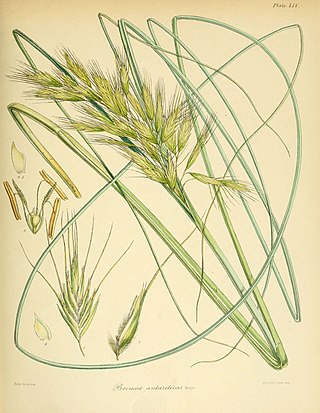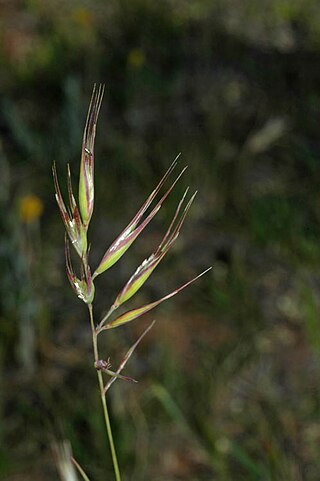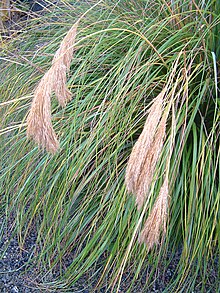
Cortaderia is a genus of South American and Central American plants in the Poaceae grass family.

Coprosma is a genus of flowering plants in the family Rubiaceae. It is found in New Zealand, Hawaiian Islands, Borneo, Java, New Guinea, islands of the Pacific Ocean to Australia and the Juan Fernández Islands.

Carmichaelia is a genus of 24 plant species belonging to Fabaceae, the legume family. All but one species are native to New Zealand; the exception, Carmichaelia exsul, is native to Lord Howe Island and presumably dispersed there from New Zealand.

Dracophyllum is a genus of plants belonging to the family Ericaceae, formerly Epacridaceae. There are 61 species in the genus, mostly shrubs, but also cushion plants and trees, found in New Zealand, Australia, Lord Howe Island and New Caledonia. The name Dracophyllum, meaning dragon-leaf, refers to their strong outward similarity to the unrelated Dracaena, sometimes known as dragon tree. Although dicotyledonous, they resemble primitive monocots with their slender leaves concentrated in clumps at the ends of the branches; they are sometimes called grass-trees.

Deschampsia is a genus of plants in the grass family, commonly known as hair grass or tussock grass. The genus is widespread across many countries.
Victor Dmitrievich Zotov was a New Zealand botanist.

Uncinia is a genus of flowering plants in the family Cyperaceae, known as hook-sedges in Australia and as hook grasses or bastard grasses in New Zealand. The genus is characterised by the presence of a long hook formed by an extension of the rachilla, which is used to attach the fruit to passing animals (epizoochory), especially birds, and it is this feature which gives the genus its name, from the Latin uncinus, meaning a hook or barb.

Gahnia is a genus of sedges native to China, Southeast Asia, New Guinea, Australia, New Zealand and a number of Pacific Islands. The common name is due to the toothed margins. It often forms tussocks.

Tussock grasses or bunch grasses are a group of grass species in the family Poaceae. They usually grow as singular plants in clumps, tufts, hummocks, or bunches, rather than forming a sod or lawn, in meadows, grasslands, and prairies. As perennial plants, most species live more than one season. Tussock grasses are often found as forage in pastures and ornamental grasses in gardens.

Chionochloa rubra, known commonly as red tussock grass, is a species of tussock grass in the grass family, endemic to New Zealand.

Tussock grasslands form expansive and distinctive landscapes in the South Island and, to a lesser extent, in the Central Plateau region of the North Island of New Zealand. Most of the plants referred to as tussocks are in the genera Chionochloa, Festuca, and Poa, also Carex.

Poa foliosa is a species of tussock grass commonly known as muttonbird poa. It is native to the subantarctic islands of New Zealand and Australia.
Lachnagrostis is a genus of African, Australian, Pacific Island, and South American plants in the grass family. They are often treated as members of genus Agrostis.

Chionochloa flavicans is a species of plant in the grass family, endemic to New Zealand.

Argyrophenga antipodum, the common tussock or tussock ringlet, is a species of butterfly commonly found in the South Island of New Zealand.

Chionochloa antarctica is a species of grass, endemic to the Auckland and Campbell Islands.

Ichneutica unica is a species of moth in the family Noctuidae. It is endemic to New Zealand and is found in the centre of the North Island and throughout the South Island. This moth is very similar in appearance to its close relatives Ichneutica phaula and Ichneutica toroneura. I. phaula can be distinguished as there is a difference in pectinations on the male antennae and I. toroneura can be distinguished as the black vein markings on the forewings is more uniform for that species in comparison to I. unica. I. unica is variable in appearance with the North Island specimens having a darker brown colour on the forewings and having a darker underside of the hindwings. This species inhabits open tussock grassland at various altitudes, coastal dunes, and inland volcanic dunes. Larvae feed on tussock grasses such as Chionochloa pallens and species in the genus Poa. Adult moths are on the wing from November to February and are attracted to both sugar and light traps.
Zotovia is a genus of plants in the grass family, native to New Zealand.

Chionochloa rigida, known commonly as narrow-leaved snow tussock and by its Māori name wī kura, is a species of tussock grass endemic to New Zealand. Two subspecies are recognised, including Chionochloa rigida rigida and Chionochloa rigida amara.

Rytidosperma erianthum, the hill wallaby grass, is a perennial species of grass found in south eastern Australia. Usually found in drier areas in a variety of habitats. The habit is somewhat variable, erect and densely tufted. The grass may grow up to 0.7 m tall.

















